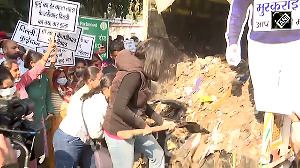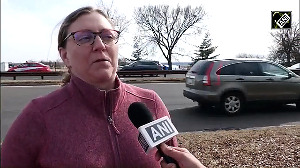The reason is simple. CDMA operators in India continue to expand their portfolio of very low-end handsets, with over 38 VLE handsets from 13 suppliers being introduced over the last few months.
Analysts say with a tele-density of only 18 per cent and an under-served rural population, the rapid growth of cheaper CDMA connections in India is expected to fire the telecom market.
"The aggressive pricing by a CDMA operator like Reliance," says Neha Gupta, senior research analyst, Gartner India, "is based on how efficiently it markets its tariff structure and bundles an affordable handset." Volume-based handset sourcing deals with Chinese equipment vendors, like Huawei, ZTE, TCL, helps the operator in further subsidising its subscriber acquisition cost further, she adds.
Consider this. For Reliance Communications or Tata Teleservices, acquiring a CDMA subscriber has become almost Rs 1,000 to Rs 1,400 cheaper than a GSM operator, according to CDMA Development Group, an industry group that promotes CDMA technology.
With CDMA operators like Reliance packaging their tariff structure at as low as Rs 777, the GSM counterparts have to lure subscribers with an entry tag of Rs 1,799 for the handset and another Rs 150 to Rs 200 for a GSM connection.
"This price war is expected to ballyhoo rural and semi-urban mobile connectivity in India," says B V Raman, country head, CDG India. A Yankee group research report too states that 64 per cent of the CDMA handsets are sub-$40 (below Rs 1,600) units.
"Handset prices can make all the difference to our bottomlines," says Naresh Malhan, president (Consumer Business), Tata Teleservices. S P Shukla, president (Personal Business), Reliance, corroborates: "Reliance Communications has made a paradigm shift in handset bundling both through disruptive pricing as well as innovative tariff plans and
incoming offers."
Arun Khanna, VP, Haier Telecom (India) adds: "There won't be a steep price drop in the handset prices, instead it will
Alok Shende, VP (ICT practice), Frost & Sullivan, says: "CDMA operators can push for volumes by lowering the entry price point for a first-time mobile subscriber."
Asim Warsi, head (marketing), Samsung reckons, "CDMA has been a pioneer in bringing down the overall prices of the mobile category. The CDMA handset prices are already below Rs 1,000." Ajay Sharma, country head, Dopod, concurs. He feels, though, the fall in GSM handsets could be up to 40 per cent, this year.
TV Ramachandran, director general, Cellular Operators Association of India, is not perturbed. He maintains that "GSM, which is nearly 80 per cent of the telecom market, has emerged as the popular choice."
According to him, acquiring a GSM customer is far better than a CDMA, "because the subscriber is not locked with a lower-quality handset".
Meanwhile, the government has extended its support to telecom companies who plan to introduce 'affordable' Rs 1,000 and low-priced CDMA handsets -- a move that is expected to increase teledensity in rural areas.
The target for CDMA base is 75 million subscribers by the end of fiscal 2007-08, according to the CDMA Development Group. With these moves, it appears very much in sight.
CDMA is becoming an attractive option
Reliance CDMA phones, according to a Prudential Equity Group Research report, are more than 20 per cent cheaper than the previous lowest-priced phone in the country.
While the GSM net-adds in India have been helped by the second-hand handset market, the competitive offering by the CDMA operators is likely to pull new subscribers into their service, states the report.
The new CDMA subscribers will lead to higher CDMA handset sales, albeit at a lower average selling prices and the availability of low-cost CDMA handsets will alleviate some concern over the lack of competitiveness of CDMA over GSM due to low-cost handset availability.
It could be a slight negative for Motorola, which has low-priced handset offerings in both CDMA and GSM (W-series and Motofone). It could also mean a slight negative for Nokia, as the lower-priced CDMA handsets are likely to pull some sales away from the GSM technology, adds the report.







 © 2025
© 2025